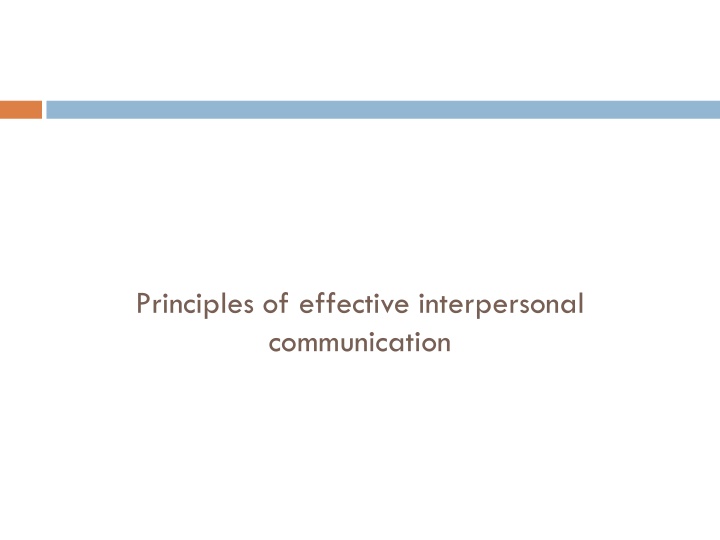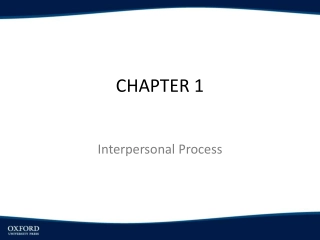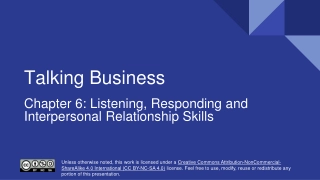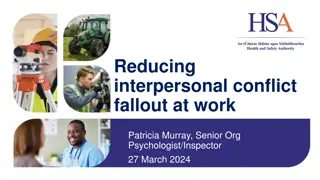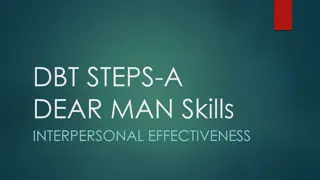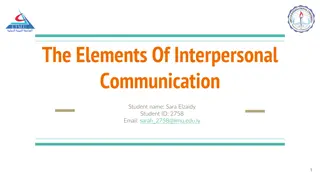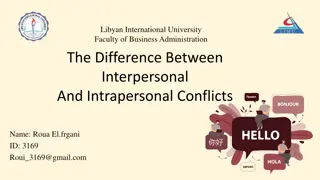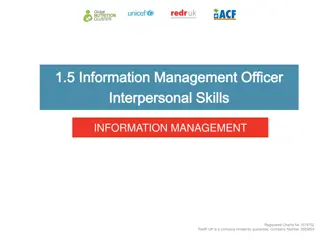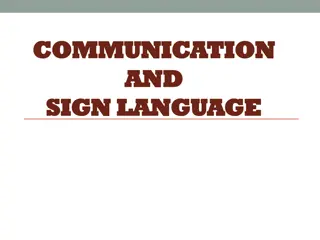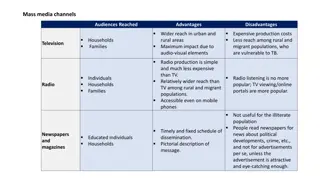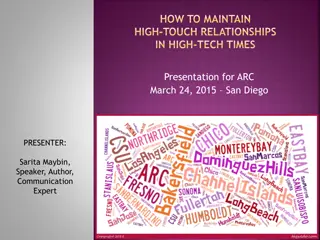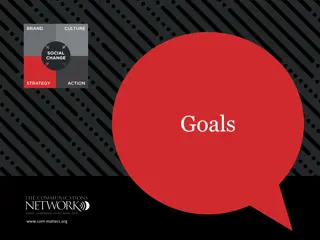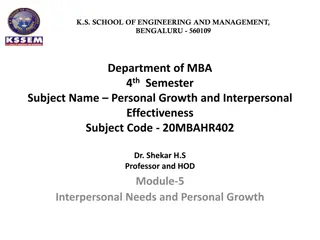Mastering Effective Interpersonal Communication: Key Principles and Strategies
Effective interpersonal communication is essential for human existence, impacting our happiness and relationships. This entails clear encoding, minimal noise, and strategic message delivery. Communicators must possess expertise, charisma, and sincerity. Messages should appeal to logic and evoke emotion, considering timing and recipient needs. Interpersonal communication involves both verbal and non-verbal cues, such as gestures and tone. Mastering these principles can lead to successful outcomes, with the message being received, remembered, believed, and acted upon by the intended audience.
Download Presentation

Please find below an Image/Link to download the presentation.
The content on the website is provided AS IS for your information and personal use only. It may not be sold, licensed, or shared on other websites without obtaining consent from the author.If you encounter any issues during the download, it is possible that the publisher has removed the file from their server.
You are allowed to download the files provided on this website for personal or commercial use, subject to the condition that they are used lawfully. All files are the property of their respective owners.
The content on the website is provided AS IS for your information and personal use only. It may not be sold, licensed, or shared on other websites without obtaining consent from the author.
E N D
Presentation Transcript
Principles of effective interpersonal communication
Communication is basic to human existence. Communication often is the root cause of why we feel happy and also dismayed. A family court judge has a special responsibility. He not only has to deliver justice; he also has to instill confidence among those who come to the court to seek justice. The perspectives of contending parties more often differ.
Five outcomes of an effective communication: The communication is received by the intended Target Audience They remember the communication They believe in the communication They have intent to act on the communication They act on the communication.
What is expected of the communicator (encoder)? Expertise (You are being constantly judged by the recipient (decoder) about your expertise in the area of consideration) Charisma ( Communication, both verbal and non-verbal reflects the charisma of the sender) Sincerity ( Things get going if the person in decision making authority is convinced about your sincerity to deliver the promise).
Message/content Logic (Does it appeal to the recipients sense of reasoning?) Emotion (Does it touch an emotion?) Appeals (Is it rational, emotional?) Timing (Has the communication reached at a time that matches recipient's urge for that)
Interpersonal communication plays an important part in the process. This comprises not only the verbal but also non-verbal communication including kinesics through tone of voice and through gesture, posture, facial expression, etc.
Comparison of Verbal and Non-verbal Communication Message Impact Type of Communication 7 percent Words 38 percent Tone of voice and inflection Facial expression, body position, gestures 55 percent
Body language can communicate: 1. Happiness 2. Surprise 3. Fear 4. Anger 5. Sadness 6. Disgust 7. Contempt 8. Interest 9.Bewilderment/Surprise 10. Determination
Twenty-seven requisite skills*, qualities, and areas of knowledge including: knowledge of child development and family dynamics; understanding of domestic violence, child maltreatment, substance abuse and addiction, and mental health issues; cultural competence and understanding one's own biases; communication that emphasizes clarity and brevity; honed listening skills; and exercising leadership from the bench. * The Modern Family Court Judge,
Interpersonal communication is irreversible You can't really take back something once it has been said. The effect must inevitably remain. Despite the instructions from a judge to a jury to "disregard that last statement the witness made," the lawyer knows that it can't help but make an impression on the jury.
Interpersonal communication is complicated No form of communication is simple. Because of the number of variables involved, even simple interactions are also extremely complex. Theorists note that whenever we communicate there are really at least six "people" involved: 1) who you think you are; 2) who you think the other person is; 3)who you think the other person thinks you are; 4) who the other person thinks /she is; 5) who the other person thinks you are; and 6) who the other person thinks you think s/he is
Finish scholar Osmo Wiio has situations akin to Murphys Law that things go wrong when you wish they should not a) If communication can fail, it will. b) If a message can be understood in different ways, it will be understood in just that way which does the most harm. C) There is always somebody who knows better than you what you meant by your message. D) The more communication there is, the more difficult it is for communication to succeed
Interpersonal communication is contextual Communication does not happen in isolation. There is: 1. Psychological context, which is who you are and what you bring to the interaction. Your needs, desires, values, personality, etc., all form the psychological context. ("You" here refers to both participants in the interaction.) As a judge you have a value system, and perspectives on gender, masculinity and relationships that wittingly or unwittingly do get reflected. Judges must control their emotions.
2. Relational context, which concerns your reactions to the other person-- the "mix. 3. Situational context deals with the psycho-social "where" you are communicating. An interaction that takes place in a classroom will be very different from one that takes place in a courtroom .
4. Environmental context deals with the physical "where" you are communicating. The ambience, the noise level, temperature, season, time of day, all are examples of factors in the environmental context. 5. Cultural context includes all the learned behaviors and rules that affect the interaction. If you come from a culture where it is considered rude to make long, direct eye contact, you will out of politeness avoid eye contact. If the other person comes from a culture where long, direct eye contact signals trustworthiness, then we have in the cultural context a basis for misunderstanding
Interpersonal communication tools by third party in resolving marital issue. When things go so wrong in a marriage that the couple seek legal remedy to annul the bond. Family courts work as a catalyst to resolve the issue, but just in case separation is the answer, then how best to close the case with the mutual satisfaction of both the parties. Counseling and Mediation are the strategies and tools used by a family court
Family court judges make decisions every day that immediately and significantly impact families. Even so, family court judges are often undervalued even by their peers on the bench. There is insufficient acknowledgement of the broad expertise required to do the job well. Rebecca Love Kourlis, former Justice of the Colorado Supreme Court.
